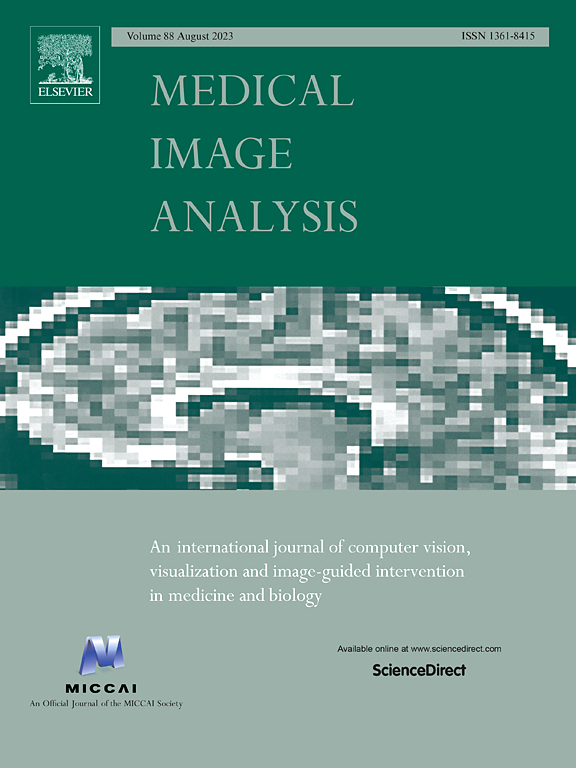Predicting infant brain connectivity with federated multi-trajectory GNNs using scarce data
IF 10.7
1区 医学
Q1 COMPUTER SCIENCE, ARTIFICIAL INTELLIGENCE
引用次数: 0
Abstract
The understanding of the convoluted evolution of infant brain networks during the first postnatal year is pivotal for identifying the dynamics of early brain connectivity development. Thanks to the valuable insights into the brain’s anatomy, existing deep learning frameworks focused on forecasting the brain evolution trajectory from a single baseline observation. While yielding remarkable results, they suffer from three major limitations. First, they lack the ability to generalize to multi-trajectory prediction tasks, where each graph trajectory corresponds to a particular imaging modality or connectivity type (e.g., T1-w MRI). Second, existing models require extensive training datasets to achieve satisfactory performance which are often challenging to obtain. Third, they do not efficiently utilize incomplete time series data. To address these limitations, we introduce FedGmTE-Net++, a federated graph-based multi-trajectory evolution network. Using the power of federation, we aggregate local learnings among diverse hospitals with limited datasets. As a result, we enhance the performance of each hospital’s local generative model, while preserving data privacy. The three key innovations of FedGmTE-Net++ are: (i) presenting the first federated learning framework specifically designed for brain multi-trajectory evolution prediction in a data-scarce environment, (ii) incorporating an auxiliary regularizer in the local objective function to exploit all the longitudinal brain connectivity within the evolution trajectory and maximize data utilization, (iii) introducing a two-step imputation process, comprising a preliminary K-Nearest Neighbours based precompletion followed by an imputation refinement step that employs regressors to improve similarity scores and refine imputations. Our comprehensive experimental results showed the outperformance of FedGmTE-Net++ in brain multi-trajectory prediction from a single baseline graph in comparison with benchmark methods. Our source code is available at https://github.com/basiralab/FedGmTE-Net-plus.
利用稀缺数据联合多轨迹gnn预测婴儿大脑连通性
了解婴儿大脑网络在出生后第一年的复杂进化是识别早期大脑连接发展动态的关键。由于对大脑解剖结构的宝贵见解,现有的深度学习框架专注于从单一基线观察预测大脑进化轨迹。虽然取得了显著的成果,但它们有三个主要的局限性。首先,它们缺乏推广到多轨迹预测任务的能力,其中每个图轨迹对应于特定的成像模式或连接类型(例如,T1-w MRI)。其次,现有的模型需要大量的训练数据集来达到令人满意的性能,而这往往很难获得。第三,它们不能有效地利用不完整的时间序列数据。为了解决这些限制,我们引入了FedGmTE-Net++,一个基于联邦图的多轨迹进化网络。利用联盟的力量,我们用有限的数据集汇总了不同医院的本地学习情况。因此,我们提高了每家医院本地生成模型的性能,同时保护了数据隐私。fedgmte - net++的三个关键创新是:(i)提出了第一个专门为数据稀缺环境下的大脑多轨迹进化预测设计的联邦学习框架;(ii)在局部目标函数中加入辅助正则化器,以利用进化轨迹内的所有纵向大脑连接,并最大限度地利用数据;(iii)引入两步输入过程;包括一个初步的基于k近邻的预补全,然后是一个采用回归量来提高相似性分数和改进估算的imputation细化步骤。综合实验结果表明,fedgmte - net++在单基线图脑多轨迹预测方面优于基准方法。我们的源代码可从https://github.com/basiralab/FedGmTE-Net-plus获得。
本文章由计算机程序翻译,如有差异,请以英文原文为准。
求助全文
约1分钟内获得全文
求助全文
来源期刊

Medical image analysis
工程技术-工程:生物医学
CiteScore
22.10
自引率
6.40%
发文量
309
审稿时长
6.6 months
期刊介绍:
Medical Image Analysis serves as a platform for sharing new research findings in the realm of medical and biological image analysis, with a focus on applications of computer vision, virtual reality, and robotics to biomedical imaging challenges. The journal prioritizes the publication of high-quality, original papers contributing to the fundamental science of processing, analyzing, and utilizing medical and biological images. It welcomes approaches utilizing biomedical image datasets across all spatial scales, from molecular/cellular imaging to tissue/organ imaging.
 求助内容:
求助内容: 应助结果提醒方式:
应助结果提醒方式:


